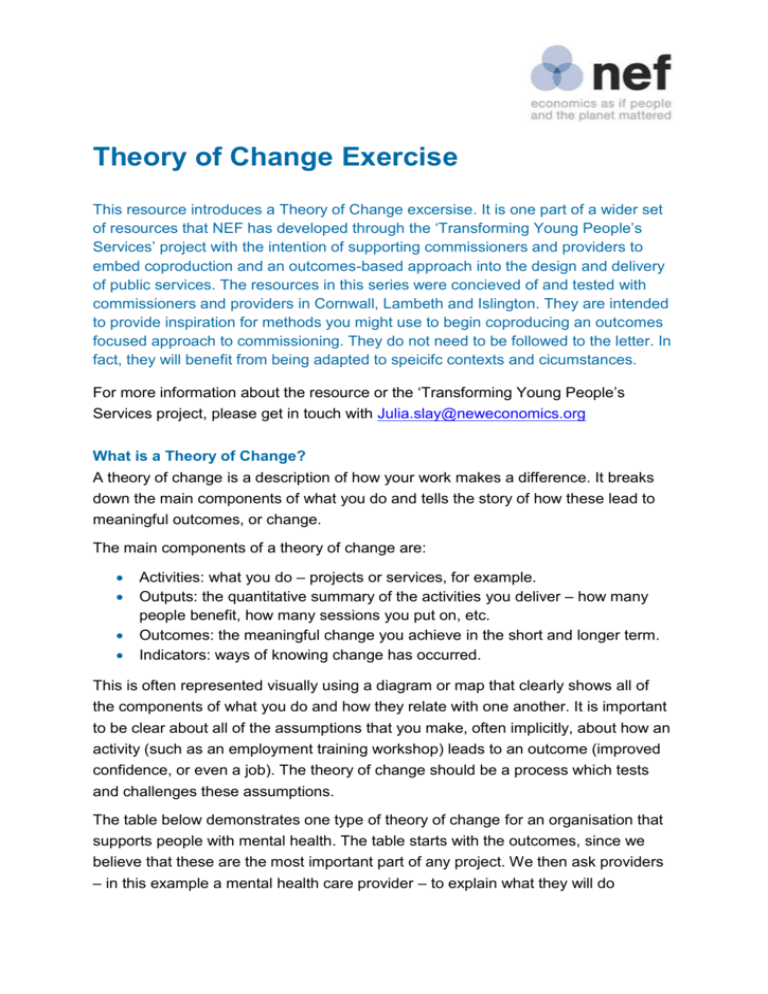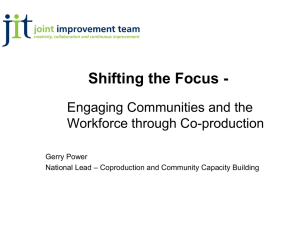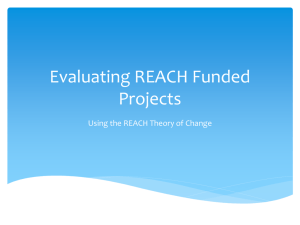Run a theory of change workshop
advertisement

Theory of Change Exercise This resource introduces a Theory of Change excersise. It is one part of a wider set of resources that NEF has developed through the ‘Transforming Young People’s Services’ project with the intention of supporting commissioners and providers to embed coproduction and an outcomes-based approach into the design and delivery of public services. The resources in this series were concieved of and tested with commissioners and providers in Cornwall, Lambeth and Islington. They are intended to provide inspiration for methods you might use to begin coproducing an outcomes focused approach to commissioning. They do not need to be followed to the letter. In fact, they will benefit from being adapted to speicifc contexts and cicumstances. For more information about the resource or the ‘Transforming Young People’s Services project, please get in touch with Julia.slay@neweconomics.org What is a Theory of Change? A theory of change is a description of how your work makes a difference. It breaks down the main components of what you do and tells the story of how these lead to meaningful outcomes, or change. The main components of a theory of change are: Activities: what you do – projects or services, for example. Outputs: the quantitative summary of the activities you deliver – how many people benefit, how many sessions you put on, etc. Outcomes: the meaningful change you achieve in the short and longer term. Indicators: ways of knowing change has occurred. This is often represented visually using a diagram or map that clearly shows all of the components of what you do and how they relate with one another. It is important to be clear about all of the assumptions that you make, often implicitly, about how an activity (such as an employment training workshop) leads to an outcome (improved confidence, or even a job). The theory of change should be a process which tests and challenges these assumptions. The table below demonstrates one type of theory of change for an organisation that supports people with mental health. The table starts with the outcomes, since we believe that these are the most important part of any project. We then ask providers – in this example a mental health care provider – to explain what they will do 2 Theory of Change Exercise (activities) to support people. We then ask providers to detail the number of people who will benefit, as well as any other outputs that might derive from the project, for example the number of meals cooked. We also ask providers to anticipate the types of indicators they will use to measure meaningful change and progress towards achieving their stated outcomes. Finally, we include a methods column, prompting providers to think about the types of methods they will use to get the information needed for the indicators. Outcomes Activities Outputs Indicators Methods Running a social enterprise café Five people with mental health issues working in the café Self-reporting on outcomes Staff observation and notes Growing food Better to use in café communication cooking skills 20 people growing food and learning about horticulture Quantity and quality of relationships with peers Peer observations Improved planning and problem solving skills 15 people take part in the training sessions Ability to work as part of a team Photo diaries Ability to set priorities and set out ways of achieving goals Selfreporting on an outcomes star Improved confidence Running cooking and food hygine courses Running catering and management training 100 hundred meals served in the café per week TOC for an imagined mental health social enterprise café We have used this with commissioners in tender documents, asking providers bidding for services to select the outcomes they are achieving, fill in the detail of the other columns and demonstrate how their proposed project will make a difference to people. This pushes providers to think clearly about the assumptions they make when (co)designing services with people. You can find more resources on ToC on the following websites: http://www.proveandimprove.org/ http://www.nef-consulting.co.uk/our-services/training-capacitybuilding/masterclasses/creating-a-theory-of-change/ 3 Theory of Change Exercise http://www.proveit.org.uk/storyboard.html How to develop your own theory of change In the following exercise we are interested in looking at what an organisation’s theory of change is in relation to four main components. The activities that they put on with young people i.e. What they do. The way that they co-produce their work i.e. How they do what they do. The outcomes that they hope and expect to see i.e. What they will achieve with and for young people The indicators they will use i.e. How they will measure progress towards the change they expect to see The exercise works through these components one by one, asking three questions at each stage: what, how and why. This may seem a little repetitive, however these questions are helpful in pushing providers to think about and justify the rationality for their proposals. The TOC exercise Timing: 1 hour Suggested format: small group work – up to six people in one group Materials: print outs of the TOC diagram (see below). This exercise was used with youth services providers in Islington. It proved to be a helpful way of challenging providers to think about what they do and how they make a difference to young people’s lives. We think it is especially useful as a way of supporting providers to respond to tender documents which are based on a theory of change model. It is best run as a capacity building workshop alongside a presentation by the commissioner on the tendering process and how it will change to be focussed on outcomes. Given their importance to this project, this particular Theory of Change (TOC) exercise focuses on co-production and measurement and evaluation, which many other TOC exercises don’t. This exercise can be done individually, in pairs or in small groups. If you have a number of people from the same organisation it makes sense to group them together. If you have a number of people from different organisations in the same group we would suggest that they choose one example to work through. This could be a real example from one of the providers in the group, or a hypothetical example that they make up together (which can be quite fun!) The aim of the exercise is to fill in the TOC diagram below. 4 Theory of Change Exercise It is worth starting out by asking providers to think about their mission – the reason that they exist. This helps to contextualise what they do and why. The next step is about co-production. It asks three questions in relation to coproduction: 1. What providers will do to co-produce (e.g. timebanking, co-design, service user groups etc). 2. How they will co-produce: How will they involve service users? At what level of decision making? What informal or formal structures support coproduction? 3. Why they have chosen these methods. The next stage is to start thinking through potential activities. The key here is again to answer the three prompt questions: 1. What activities will you run? 2. How will you run them? 3. Why will you run those activities in that way? You’ll notice that above the activities and co-production boxes there are three prompts for people to consider: partners; local assets; and, other resources. These 5 Theory of Change Exercise are supposed to encourage providers to think about how they could make the most of these when coproducing the activities that they run with young people. The next stage concerns the outcomes and again asks the same three questions. 1. What outcomes do they hope and expect to see? Using the prompt question ‘so what?’ can help to identify outcomes. For example, if young people attend a training course (output), so what? If their IT skills improve as a result, so what? Asking questions in this way can help push you to think about chains of outcomes and how these are linked. 2. How will these be achieved? (e.g. what is the conceptual link between the activities, co-production and outcomes – push people to go beyond the obvious answers of “the outcomes will be achieved as a result of the activities). 3. Why will working in the ways they have outlined produce these outcomes? Finally we come to the section on indicators. Here we are asking providers to consider: 1. What indicators they will choose. 2. How they will gather information on these indicators (their evaluation methods). 3. Why they have chosen these indicators and methods. We have published separate guidance into how to identify indicators that might be helpful for providers when completing this section. When done well a theory of change is useful for providers as well as commissioners. Providers can use a theory of change model to focus and refine the work that they do. It can be kept as a working model for the organisation to refer back to whenever designing new projects, or when they feel existing projects might need adapting. By making co-production and outcomes the focus of this theory of change, we are stressing that there are two fundamentally important aspects of any organisations work: what they achieve and how they achieve it.








